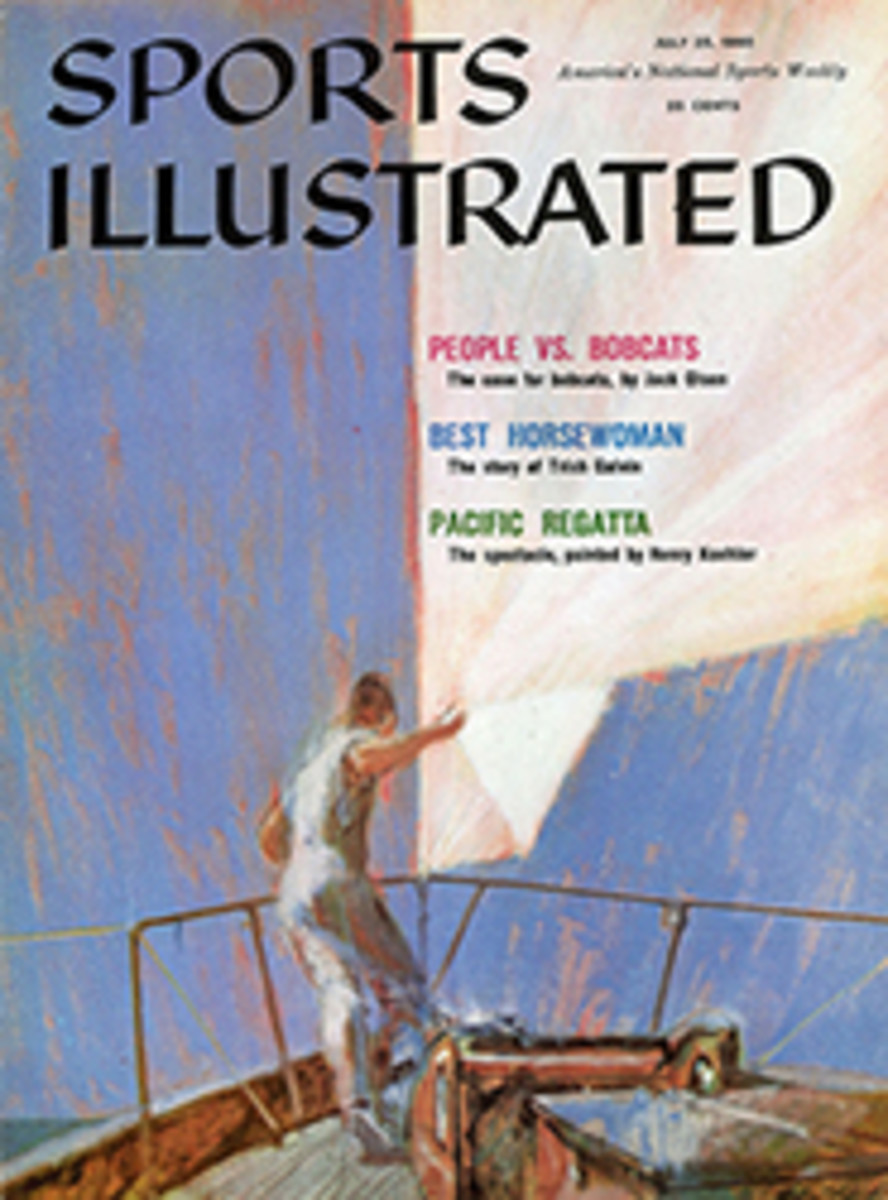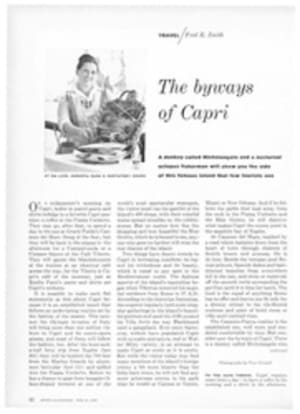
THE SECRET OF BERMUDA
If there is a single key to victory among all the variables that beset the skipper in the 635-mile race from Newport to Bermuda, it is the Gulf Stream—a mysterious force which has puzzled navigators and baffled scientists since the time when the Atlantic first became a charted sea.
To modern yachtsmen as to ancient mariners the Stream can be boon or bane. In ocean racing the fastest course is likely to be the shortest distance between two points, called the rhumb line. But athwart the Newport to Bermuda line, some ‚Öì of the distance down, flows this current of warm water, so powerful but so erratic that modern oceanographers sometimes compare it to the jet streams of the stratosphere. It can make or break a boat's chances of winning. Going in to the Stream too far west or too far east entails extra distance, and getting caught in an unfavorable meander means certain defeat.
How can one turn to advantage a fickle current flowing in a waste of water? To the layman it may seem impossible; actually, thanks to the interest and cooperation of scientists and sailors, the Gulf Stream is increasingly becoming a known quantity and, to a degree that is often surprising, a predictable one.
The chart at left shows one result of this research work: a picture of the Gulf Stream as it flowed and eddied between the Grand Banks and Cape Hatteras over a two-week period in 1950. Compiled by six research vessels making continuous observations for the Woods Hole Oceanographic Institution in Woods Hole, Mass., it serves to illustrate some of the complexities that face the ocean racer as he plans the strategy and tactics which will take him across the Stream down to Bermuda.
Since the Woods Hole scientists keep the Stream under more or less continuous observation, they have sometimes been able in recent years to furnish the Bermuda contestants with a picture closely adapted to their needs. Thus, before the 1956 and 1960 races, they briefed contestants on the general characteristics of the Stream in the area where it would be encountered and furnished each boat with a chart based on recent sea and air reconnaissance. This year, for example, they told us that during April and May the Gulf Stream had remained "unusually steady," but that they had found "a counterclockwise eddy south of the Stream, centered in April at 36° north and 64° west. This eddy," they added, "may have wandered westward or disappeared''—but it was something to be aware of, and they gave us the currents observed (2 to 3 knots) and their flow in various positions.
In 1958 there was a verbal briefing, but no prediction was issued, so it became necessary to revert to the old guess-and-hope system. Yet in all three cases, for Finisterre, the same basic technique seemed to work: a combination of applying Woods Hole recommendations, a seat-of-the-pants feeling for the ocean, and prayer.
West of the rhumb
First, a course was laid westward of the rhumb line to a theoretical point labeled Point Able on the chart where, according to all assembled data, the northern limit of the Stream should be encountered. Our actual entry was established by water temperature readings. Immediately on entering the warmer water of the Stream we altered our heading to the Newport-Bermuda rhumb line compass course, hoping to bring the flow of current on the beam. Thermometer readings were continued at half-hour intervals; when a drop became apparent, we knew Finisterre should have arrived at Point Baker on the far side of the Stream. If all the variables worked in our favor, we would be set back on or close to the rhumb line, able to sail the shortest course to the finish.
In 1956 the track of the Stream was believed to be nearly at right angles to the course. Establishing the temperature of Continental Slope water (beyond the 100-fathom curve) with a sensitive thermometer, we found it a uniform 69° Fahrenheit. Between 10:30 and 11 p.m. Sunday it jumped 10°, and we knew we had entered the Stream 40 miles west of the rhumb line.
In 1958 the temperature gradient was less defined. For many hours the ocean water stood between 70 and 72° , then rose gradually, never exceeding 76°, so we did not experience the sharp rise, definitely proving contact. Yet, instinctively, in the predawn hours of Monday we were sure Finisterre had entered the Stream. Collectively, those aboard had sailed in or through the Gulf Stream scores of times, and there is something about the feel of the sea—a short wicked bobble, confused in character and direction—which is unmistakable. This time we were 35 miles west of the rhumb line.
In 1956 and 1958 Finisterre entered the Stream alone, but this year 30 competitors were in sight, grouped around Point Able some 44 miles west. As predicted, we all found the favorable sector of a horseshoe-shaped flow which set us to the south and east, but not, as hoped, back to the rhumb line. At Point Baker, navigational fixes placed Finisterre 20 miles west, forcing a basic decision to abandon our competitors and revert to the race we thought best.
Thus, apparently, if there is a Gulf Stream secret rule of thumb it is to enter the Stream approximately 40 miles west of the rhumb line. Naturally, the weather is a factor in the decision. The lighter the breeze and the longer in the current, the greater the amount of drift. As Woods Hole has recorded velocities up to 5 knots in a 20-mile band near the axis, in faint airs a boat will be going sideways faster than she will be forging ahead. And to weather variables must be added the vagaries of the Stream itself. Scientists now consider it as a system of overlapping currents arranged somewhat like the shingles on a roof, rather than a flowing river. These currents shift in various directions and even form completely detached whorls.
Yet no matter how sailors may curse it, the Gulf Stream is not only the key to victory or defeat but the secret of the fascination and importance of the Bermuda Race, a hurdle adding zest to what would otherwise be a routine stretch of ocean.
CHART
THE RESTLESS MOTION of the Gulf Stream is graphically shown in this chart, which covers one two-week period in which current even formed a separate eddy.
COLD CENTERS OF CYCLONIC EDDY
[TWO BLACK LINES]8-12 JUNE
[THICK BROWN LINE]19-22 JUNE
DIAGRAM
THREE RACES and three victories are shown in these diagrams of Finisterre's, courses in 1956, 1958 and 1960. In each case Mitchell set his initial course west of the rhumb line and was then set back toward it when he entered the Gulf Stream. Biggest boost came in the 1960 race for Finisterre's grand third victory.
1956
NEWPORT
1st day
Gulf Stream
2nd day
3rd day
BERMUDA
DIAGRAM
[See caption above.]
1958
NEWPORT
1st day
2nd day
3rd day
4th day
BERMUDA
DIAGRAM
[See caption above.]
1960
NEWPORT
1st day
2nd day
Gulf Stream
3rd day
4th day
5th day
BERMUDA

